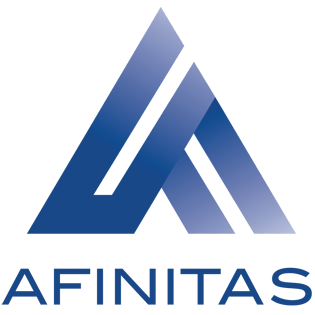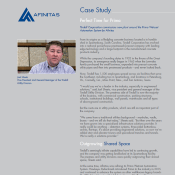
From its origins as a fledgling concrete business located in a humble shed in Spartanburg, South Carolina, Tindall Corporation has evolved into a national powerhouse prestressed/precast company with leading-edge technology and a large footprint in the manufactured concrete products industry.
While the company’s founding dates to 1932 in the throes of the Great Depression, its emergence really began in 1963 when the Lowndes family purchased the small business, expanded into precast concrete utility pipes and then into prestressed products – and never looked back.
Now, Tindall has 1,500 employees spread across six facilities that serve the Southeast, including two in Spartanburg, and locations in Petersburg, Va., Connelly, Ga., Moss Point, Miss., and San Antonio, Texas.
“I would say we’re a leader in the industry, especially in engineered solutions,” said Joel Sheets, vice president and general manager of the Tindall Utility Division. The prestress side of Tindall is now the majority of the business, with commercial construction, parking structures, schools, institutional buildings, wall panels, warehouses and all types of above-ground construction.
But the roots are in utility products, which are still an important part of the company.
“We come from a traditional utilities background – manholes, vaults, boxes – and we still do that today,” Sheets said. “But then over the years we have grown into a specialized infrastructure solutions provider. It really could be anything – detention systems, three-sided bottomless, arches, flat-tops. It’s about providing engineered solutions, so now we’ve added stair and elevator towers and specialized trenches and tunnels. We’re really a solutions provider.”
Prima System: Tindall Case Study
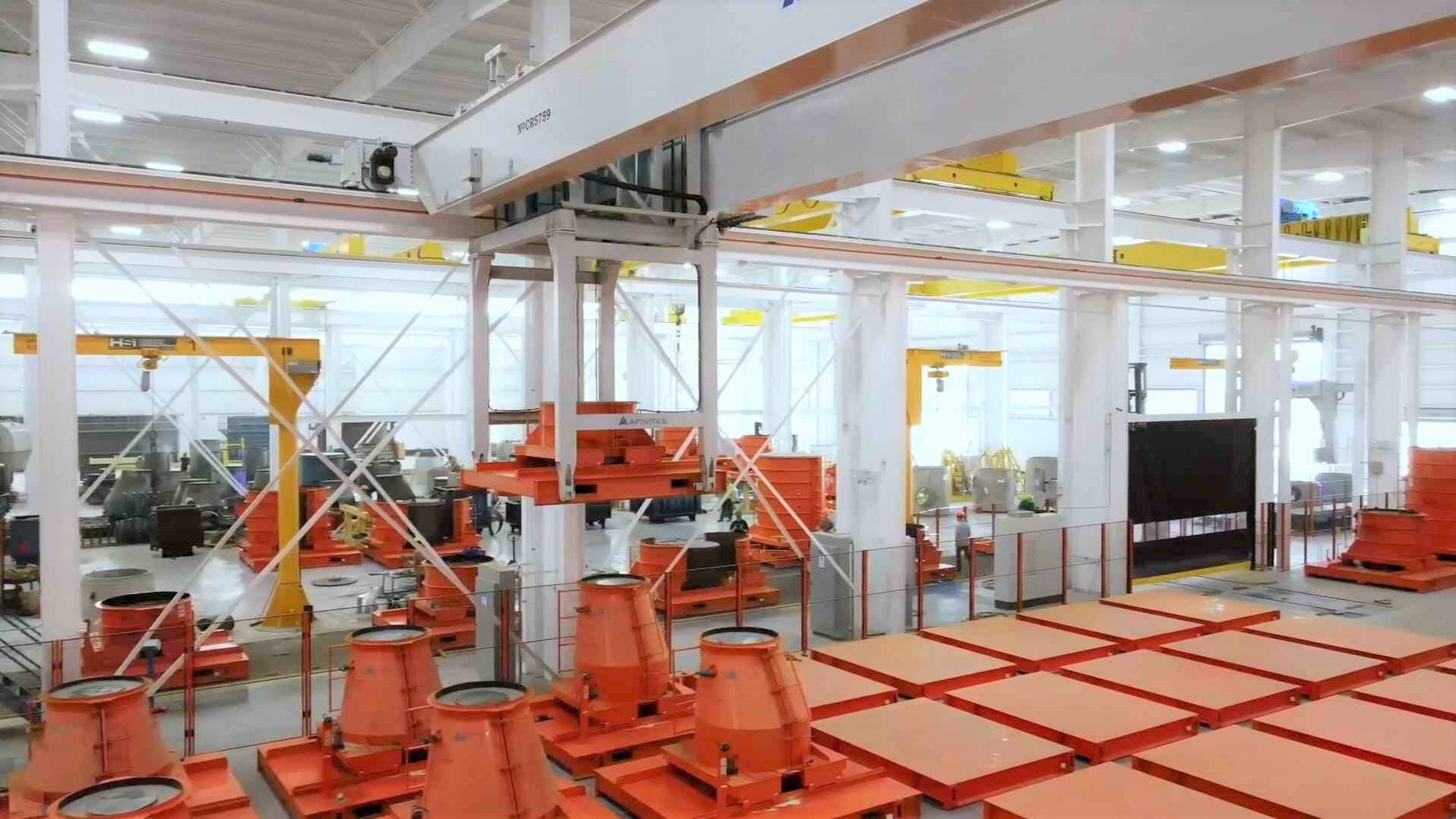
Outgrowing Shared Space
Tindall’s seemingly infinite capabilities have led to continuing growth, and the company was getting landlocked at its Spartanburg facility. The prestress and utility divisions were quickly outgrowing their shared space, Sheets said.
At the same time, Afinitas was refining its Prima Wetcast Automation System. HawkeyePedershaab introduced Prima to the industry in 2015 and continued to enhance the system as other well-known legacy brands like BFS, New Hampton Metal Fabrication and Spillman Company joined the Afinitas family. Prima had established itself as a premier
automation system for the precast industry, and now Tindall was looking for an automation solution.
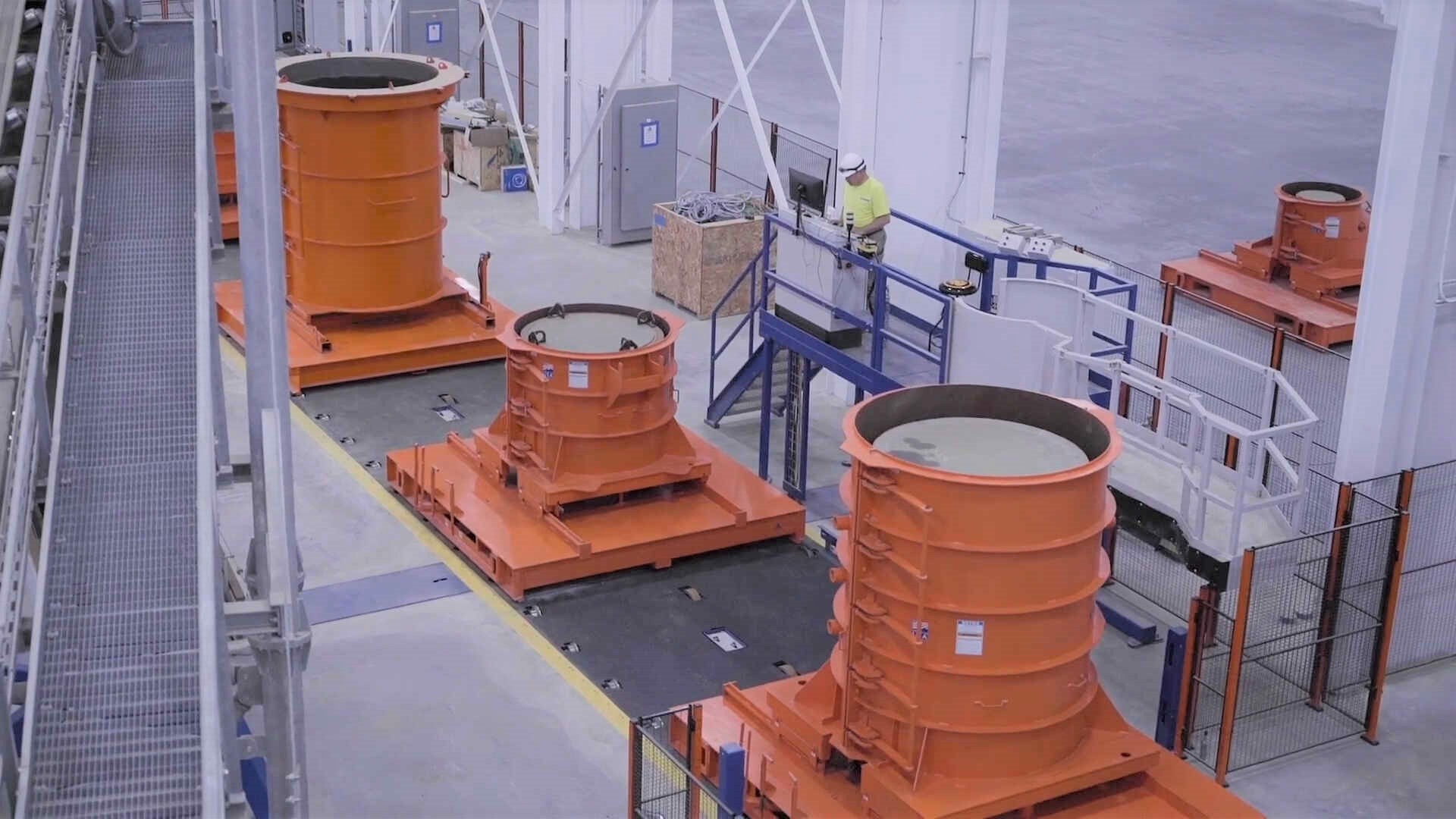
The Prima process line brings the forms to the worker saving steps and reducing the labor input per piece.
Perfect Timing for Prima
“The timing was really a great thing,” Sheets said, “Prestress had just added a new proprietary product line and the Utility Division was on the move. So, it really drove the decision where one division had to split off from our shared location.”
In an era where labor shortages are severe and persistent, dynamic companies like Tindall still need to find a way to meet growing demand. The goal was to increase Tindall’s capacity and capability without increasing labor by the same amount, Sheets said.
“We had been investigating automation so we could better utilize our workforce and have the ability to make more with the folks that we have,” Sheets said. “Automation was going to be a key part of our move to a new location. So, we evaluated systems, and because Afinitas had so many companies rolled under one umbrella, it made the most sense to us.”
In addition to the Prima system, Afinitas added into the lineup its new Prima Base, a monolithic manhole base casting system that works in
tandem with the Prima production line and makes it easy to create
customized inverts for manholes. Prima Base sealed the deal for Tindall.
“That might have been one of the biggest deciding factors driving us toward a total Afinitas package,” Sheets said. “And the timing was just right because the division was growing, we had the opportunity to move to a brand-new plant, and we built it around the Afinitas Prima system.”
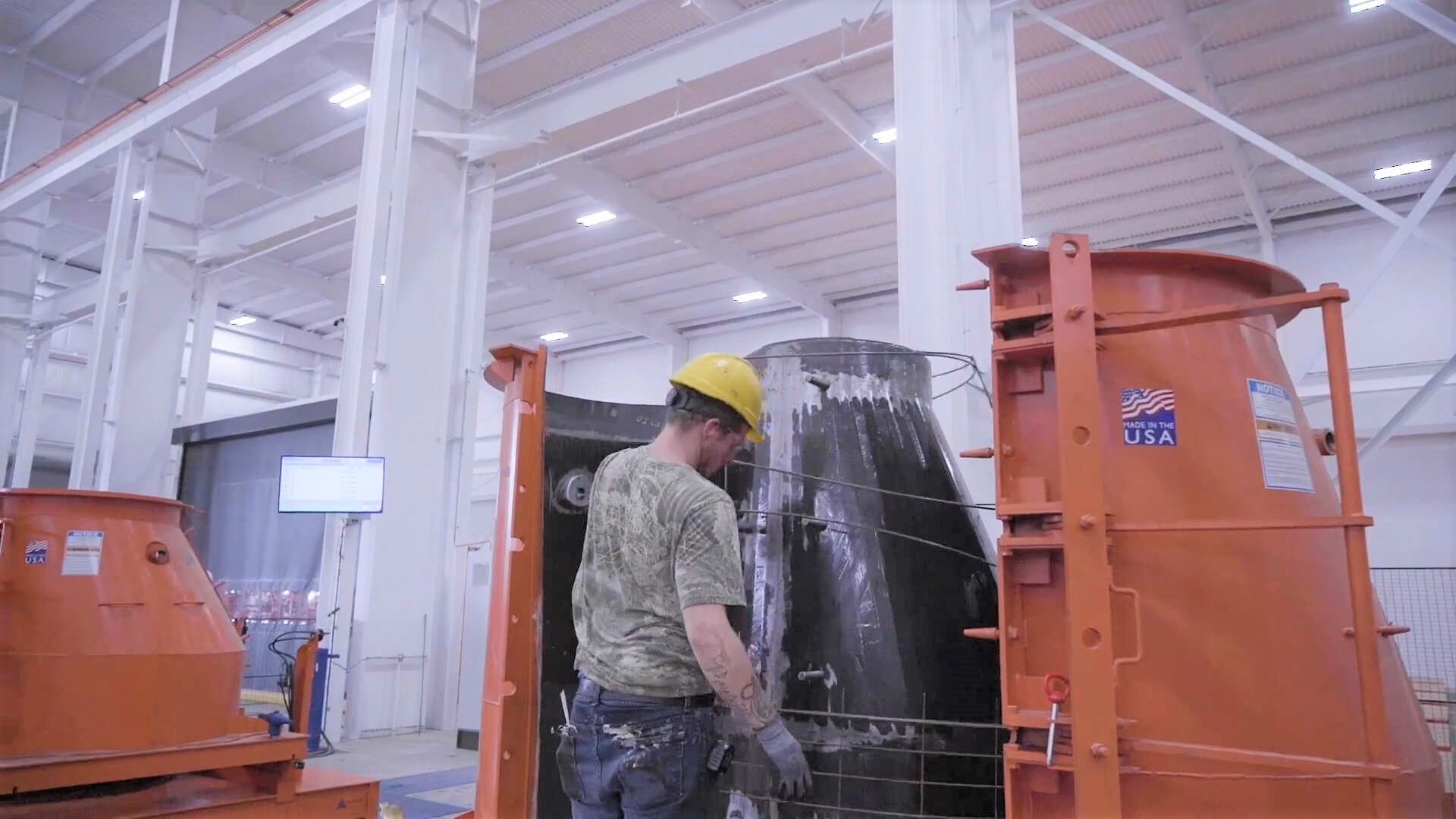
Each form contains an RFID tag that contains pertinent information like location, processing times, concrete mix, vibrator settings, among others.
Tracking Metrics, Improving Safety
Prima is relatively new to the precast concrete industry, but the concept has been around since Henry Ford invented the assembly line in 1913. While Prima’s operating system is many times more complex than the original Ford line, the idea of moving the product down an assembly
line is at the heart of Prima. The big difference between the original assembly line and Prima is the vast amount of information that Prima collects along the production loop as it tracks metrics, providing data
for planning, training and efficiency improvements.
The automated production line benefits the employees “in many, many ways,” Sheets said. “Probably the chief one is from a safety and work task scenario.” Prima eliminates the need for fork lift trucks in the
production area and eliminates overhead transport of products and concrete buckets, enhancing safety.
The Prima system consists of a production loop where the forms automatically circulate through specialized workstations. When a task is completed, the station is reported “ready” and the molds move to the next position.
“The people are far more stationary,” Sheets said. “The forms are coming to you. And so, if your task is always to set up a form, that’s what you are exclusively doing, and you’re getting really good at it. This gives you the opportunity to be an expert at what you’re doing as opposed to having a roving crew moving from form to form to form. Your tools are always right there with you, so you’re not having to go around looking for tools. That’s a benefit to the company and the employee.”

“One of the principles of lean manufacturing is creating a flow, and that’s what you are doing with Prima.”
– Jason Banwart, Afinitas Director of Technical Sales
Prima Creates A Flow
Jason Banwart, Afinitas Director of Technical Sales, said that the
principles of Prima are based on lean manufacturing, which is geared
to increasing worker productivity, improving efficiency and reducing waste.
“One of the principles of lean manufacturing is creating a flow, and that’s what you’re doing with Prima,” Banwart said. “You’re not
bringing the tools and material to each mold. You’re bringing the mold to the people. It drastically reduces the labor input per piece, because
of that assembly line efficiency. Each worker is doing a certain task at
a certain station all day long, and that system is hitting cycle time all
day long, so it really drives efficiency and drives down the labor
content in every piece.”
Which means that the Prima system meets the core objective of Tindall’s new automation push – increasing the output rate of products without increasing labor.
Not only that, the Prima system enables Tindall to cure much larger products than it could using its previous kiln that limited the size of the products they could cure.
The Tindall configuration is the largest Prima system Afinitas has
designed to date, Banwart said. It includes an inventory area with 130 spots for product. The factory has four bays – one running the length
of the building for the inventory; a second bay that houses the actual Prima loop assembly line; a third bay for rebar and a fourth bay for extra-large forms that will not fit into the Prima system.

Prima doesn’t need to stop to reconfigure for a new product. You can run different sizes all together down the same line with the same operators.
Multiple Products on the Same Line
The beauty of Prima is that the line doesn’t need to stop to reconfigure for a new product. It runs seamlessly, and for Tindall that means any combination of 4, 5 and 6-foot diameter manhole bases, risers, and cones, many sizes of storm boxes and a variety of other products.
“We’ll have 110 to 120 forms in the Prima system just to start,” Sheets said. “You can run them all together down the same line and the same operators will be able to efficiently cast each one.”
This variability is accomplished through RFID tags on each mold,
Banwart said.
“The RFID tag contains information about the product. When it comes
to the fill station, Prima reads the tag and knows which mold is there.
It knows that we need this much concrete at this volume. It knows the
estimated time needed at each station. So, all the data for that one
product is contained with the RFID tag.”
In addition to the operators at each workstation, Prima has a main
operator on an elevated platform who can control the entire production line as well as the fill station.
The basic production jobs are still the same,” Banwart said. “You still
have to pull open the mold. You still have to clean it after it’s stripped
and place the reinforcement back in. But everything you need to
accomplish that is right at your fingertips.”
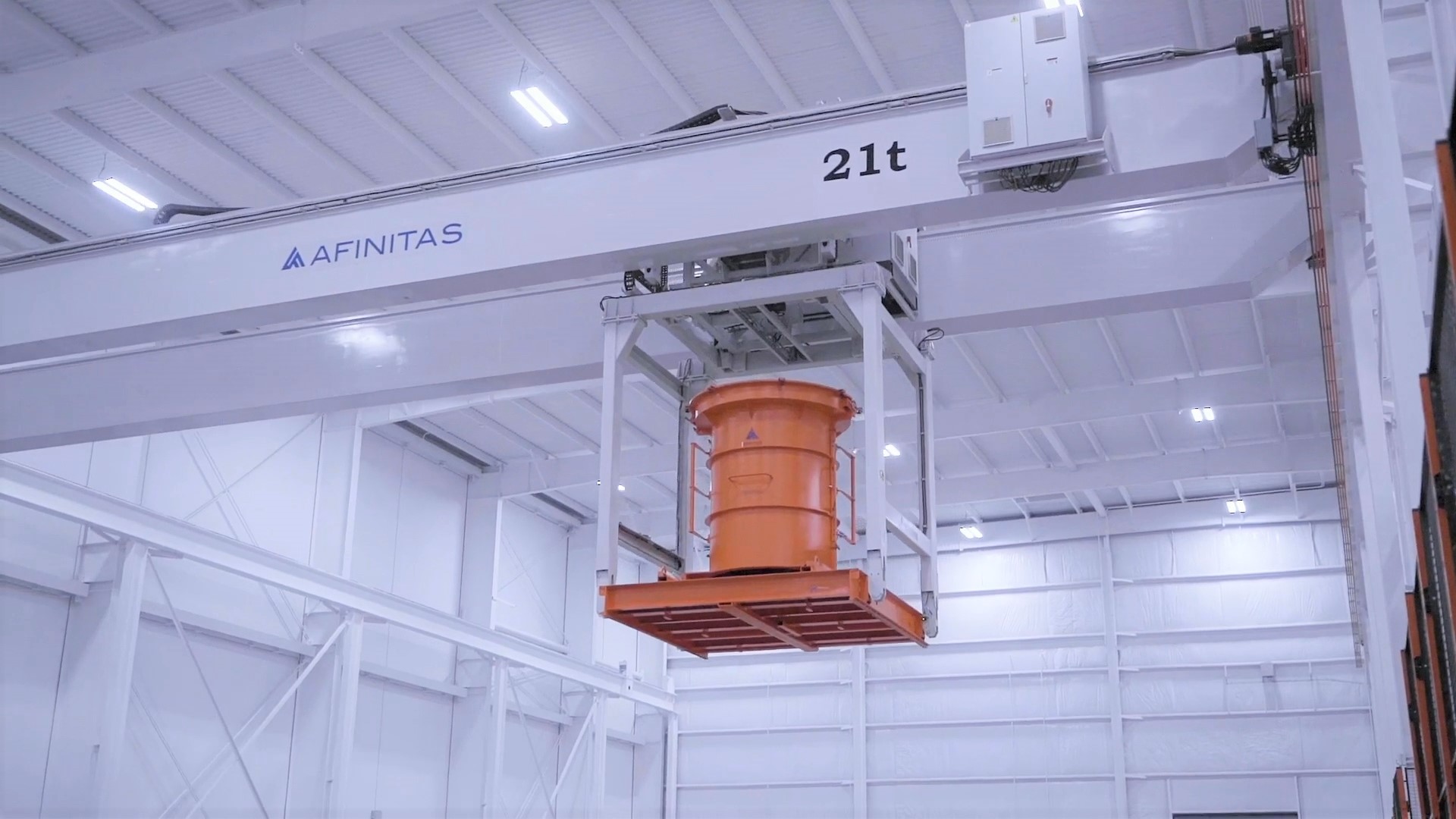
Prima’s automatic overhead manipulator.
Bringing It All Together
While every greenfield construction project comes with a myriad of
challenges, Tindall came into the year-long project with a comfort level,
because of its history with the individual Afinitas brands, Sheets said.
Banwart concurred.
“It was probably the most organized pre-sale meeting I’ve ever been
a part of,” Banwart said. “They had the building contractor, the batch
plant supplier, the aggregate heating supplier and the whole Afinitas
team in one meeting talking about the details.
“It was really a great project for Afinitas,” he added, “because we
had four of our companies all coming together to produce this system.
We had BFS with the Prima Base, HawkeyePedershaab with the Prima
system and the forms supplied out of our New Hampton and Spillman
facilities.”
For Tindall Corp. and Sheets, beyond the production gains just seeing
the looks on the faces of his production team was worth the hard work
of commissioning a new plant. “Just standing here, you’re in a brand
new, clean, bright factory. A lot of consideration was placed into the
worker experience,” he said.
“It is also satisfying for the Afinitas group, which has been working to
bring together its legacy companies coming together as one company
and producing a world-class system,” Banwart said.
That’s a world-class system for a world-class company, and it happened
at the perfect time.
Benefits of the Prima System
- Ease labor issues – up to 50% labor reduction over traditional wetcast plants.
- Increase profitability and throughput – track productivity down to the piece.
- Improve plant conditions – attract andretain better employees with a clean and comfortable work environment.
- Position your company as a leader –win more business with automated processes that increase output and shorten lead
times.
